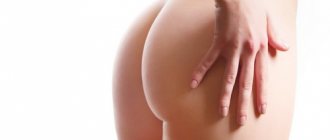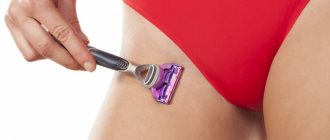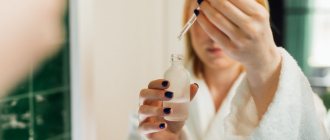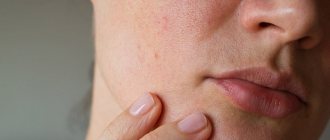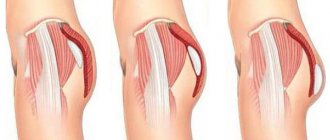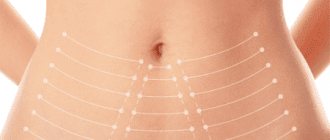First of all, we note that dimples on the buttocks are a completely normal phenomenon due to the structure of the gluteal muscles. But because of the fashion for voluminous rounded butts, women are quite picky about the shape of the butt. Well, if there is demand, there will be supply. In this article we have collected the most effective exercises to solve this problem. Using the presented recommendations and training methods, you can visually remove the depressions on the sides of the buttocks and make your butt more beautiful.
Reasons for appearance
When a hole appears on the leg, only an experienced specialist can definitely say after diagnostics what it is.
Dents can appear both due to pathological internal processes and due to the negative impact of environmental factors. To say exactly why a dent appeared on the legs above or below the joint, you need to conduct instrumental diagnostics and take an anamnesis.
Most often, pits on the legs appear due to the following factors:
- hormonal changes. After childbirth, almost every woman experiences changes in the production of hormones, which can lead to changes in the structure of subcutaneous tissue and fat deposits;
- damage to muscle fibers due to labor;
- receiving a direct blow to the leg;
- muscle injury during sports;
- constant changes in weight (such a disorder can be provoked not only by very rapid weight loss, but also by weight gain);
- lipoma - tumor formations of benign or malignant origin in the fat layer;
- neuropathy of the anterior femoral nerve due to progressive osteochondrosis (this deviation can also develop against the background of a herniated disc);
- pathology of the rectum. With an abscess or paraproctitis, the pressure on the spinal column will be increased, which can cause pinched nerves in the lower extremities;
- spondylolisthesis of the spinal column. The main characteristic of this pathology is a change in the position of the vertebrae, which can provoke a pinched nerve;
- piriformis syndrome. The main characteristic of this pathology is the development of an inflammatory process or hypertrophy of the piriformis muscle. Also, such a disorder is very often accompanied by pinching of the sciatic nerve;
- muscle rupture during sudden lifting of weights or professional sports;
- the presence of inflammatory pathologies affecting the pelvic organs;
- Stage 4 cellulite.
Another common cause of indentations in the legs below the knee or above the joint is constant and prolonged pressure on the tissue. For example, such pressure can be exerted during long workouts at the gym, especially if a person spends too much time on one machine. Also, pressure on a specific area is possible in certain professions.
It is worth noting that mechanical impact leads to such changes quite rarely (no more than 8% of cases). That is why, if a hole appears on the leg, it is recommended to immediately make an appointment with a doctor, who will tell you what caused the defect and what needs to be done in a particular case.
What defects remain after acne and boils
If the patient squeezes out the abscess incorrectly, an ugly scar may remain in its place. There are two types of acne marks:
- Hypertrophic formation. This is a small dense nodule formed from excess production of regenerating tissue. Sometimes scar tissue is indistinguishable in color and texture from healthy dermis. In this case, uniform tubercles appear on the face. Visually noticeable scars and scars are the same excess tissue that differs in color from the skin (most often the seals are white or pinkish).
- Atrophic scars form when the connective tissue fails to completely cover the acne holes. These scars look like depressions of different shapes and diameters. Based on the visual characteristics of atrophic scars, the cosmetologist determines after what type of rash they formed.
Sometimes, after a squeezed out pustule, dark spots remain.
Most often they appear because during the process of cell regeneration an increased concentration of melanin pigment is released. However, spots can also appear due to infection of the ulcer or untimely treatment of acne.
Diagnosis of chronic venous insufficiency
The success of future treatment depends on a correct and accurate diagnosis. The many manifestations of CVI and the presence of several possible causes for the development of the disease dictate the need to supplement the medical examination with what is called the “naked eye.” The main method for diagnosing venous diseases is duplex ultrasound scanning (USDS), which allows you to determine the location of the affected veins and the nature of the disturbance in venous blood flow. However, this is a subjective method, and in modern phlebology it has become the rule that the attending physician can perform ultrasound scanning himself. Additional research methods are rarely used, but in some cases they can significantly affect treatment tactics. These include X-ray contrast venography, computed tomography (CT), magnetic resonance imaging (MRI).
Pathologies of the acetabulum
Impingement syndrome is considered one of the rare anomalies of the articular notch. The disease stands for femoroacetabular impingement syndrome, when the head of the bone collides with the surface of the socket. This interferes with walking, running and causes pain. A feature of the pathology is the difficulty of diagnosis, since not all doctors are aware of the syndrome.
Other diseases of the acetabulum encountered in medical practice:
- Fracture. Can be simple or complex. In the first case, the fracture line passes through one bone, in the second - through several. Complications such as sepsis, suppuration, bone necrosis, and nerve damage may also occur. The symptoms are the same in all cases. The patient feels pain in the hip joint and groin area and is unable to move normally. The leg itself can be rotated externally or internally.
- Dislocation. All types of dislocations are characterized by acute pain, deformation of the hip joint and the inability to perform normal movements. Often you have to take a forced position of the limb.
- Arthrosis. An accurate diagnosis can only be made after radiography. The photographs will clearly show inflammatory changes in the bones with overgrowth of connective tissue.
- Otto's disease or dysplasia. A congenital disease characteristic only of women. To determine the disease, hardware diagnostic methods are used. Studies are carried out on girls at an early age if there is suspicion from a doctor. These include limited hip movements and shortening of the lower limbs.
Why is it important to fight this?
Firstly, if a dent forms on the thigh, it creates some problems in the musculoskeletal system. The load is not distributed evenly. As a result, the area where such trouble has arisen experiences more pressure than it should ideally.
And this leads to damage over time. Especially if a person leads an active lifestyle.
Secondly, it often prevents you from moving as before. The person is able to walk, but sudden movements may cause pain, which again arises due to some disorder in the musculoskeletal system. This becomes especially noticeable when running and jumping.
If this is a muscle problem, then this creates discomfort in terms of aesthetic perception. This problem is especially striking if a person is of large size (we are not talking about excess weight, in which no dents will be noticeable)
That's why it's important to solve this problem too
What to do if it's a muscle problem
In this case, exercises that will make other parts of the buttocks voluminous will help. As a result, the overall size of the buttocks will increase, and dimples will no longer be noticeable. It is unlikely that you will be able to achieve results on your own. It is better to contact a competent trainer at the gym so as not to aggravate the situation.
Unfortunately, it is not possible to simply return pumped muscles to their previous state. Yes, if you don’t put stress on them, they will atrophy over time. But the problem is that this means a strong restriction of movement in principle, which entails not only problems of a domestic and social nature, but also health problems. So this is not an option.
The trainer will assess the condition of the muscles, take into account the person’s proportions and draw up a training plan that will help level out the dents. The main task will be to align the muscles relative to each other, so that in the end all muscle groups of the buttocks are equally developed.
This will require a set of exercises with loads. Squats will also help. If a person is large in size, squats will be difficult for him for physiological reasons, and it will be easier for him to achieve results on the machine
It is also important to take into account the hereditary factor, on which the speed of pumping certain muscles depends to a certain extent. And the trainer should ideally constantly monitor the results in order to adjust training if necessary
If the problem is in the bones
You won’t be able to change anything here on your own. You will need to consult with a doctor and make a joint decision about the permissibility of bone grafting or another option to remove the problem. This will be followed by surgery to restore the bone in the hip to its previous level.
However, it is worth considering that for restoration you will need to take bone from another part of the body. Therefore, it is worth resorting to such a procedure only if the dent really poses a serious threat to the musculoskeletal system.
If there is none, and only a cosmetic defect is observed, the operation is not justified. Indeed, during this process, most likely, a cosmetic defect will occur in the place where the bone will be taken.
Pathological condition due to damage to the nervous system
The formation of a dent below the knee on the leg is usually the result of neuropathic manifestations affecting the nervous system of the thigh. A dimple in the leg below the knee can have a variety of causes, but usually a dimple occurs when the muscles receive incorrect signals from the brain centers.
Neuropathy is provoked by various pathologies:
- overload, it causes hemorrhage in the lower back muscles;
- lymphoma;
- sarcoma;
- peritoneal hematoma, this phenomenon can be provoked by hemaphilic manifestations or platelet dysfunction.
Sarcoma of the knee
Overuse can lead to compression of the nerve, which leads to dysfunction in the muscles receiving signals from the brain. Usually a woman encounters a similar condition during pregnancy. Her body experiences a lot of stress, since as a result of the child’s development, his body weight increases. This load complements other tasks performed by a pregnant woman throughout the day and leads to an excessive increase in pressure on the legs, spine, especially the lumbar region.
Nerves play the role of pathogens that lead to the appearance of indentations in the leg muscles if protrusion develops in the spine.
To reduce the degree of pressure, it is necessary to use a special bandage in this condition, which helps to hold a large amount of load.
A set of exercises for 30 days to pump up the buttocks on the side
This complex was specially created for people who want to pump up their thighs without gaining excess fat. The graph will tell you the required number of repetitions for each exercise and the recommended number of approaches.
| Day 1 3 sets of 8 reps each exercise | Day 2 3 to 8 | Day 3 rest | Day 4 3 to 10 | Day 5 3 to 10 |
| Day 6 rest | Day 7 3 to 15 | Day 8 3 to 15 | Day 9 rest | Day 10 3 to 18 |
| Day 11 3 to 18 | Day 12 rest | Day 13 2 to 25 | Day 14 rest | Day 15 3 to 20 |
| Day 16 3 to 20 | Day 17 rest | Day 18 3 to 25 | Day 19 3 to 25 | Day 20 rest |
| Day 21 3 to 30 | Day 22 rest | Day 23 3 to 30 | Day 24 rest | Day 25 3 to 32 |
| Day 26 rest | Day 27 3 to 32 | Day 28 rest | Day 29 3 to 35 | Day 30 rest |
Recommendations for activities
To remove dimples on the buttocks, follow these training recommendations:
Focus on basic exercises that build volume. Work out the relief of the buttocks with insulating elements at the end of the lesson. Don't forget about recovery. Girls need to rest at least 1-2 days between butt workouts.
Perform basic exercises for 3-4 sets of 12-15 repetitions, isolating exercises for 3-4 sets of 15-20 repetitions. Don't chase the scales
The most important thing in glute training is to feel the tension in the target muscles. Change your training plan every 8-10 weeks so that your buttocks do not have time to get used to the load. If you are overweight, do moderate cardio sessions (biking, outdoor games, running, walking) on weekends.
And, of course, don’t forget about healthy eating. Avoiding sweet and starchy foods will help you gradually reduce your body fat. And natural meat, fish, poultry, vegetables, herbs, cereals, vegetable oils will help increase the volume of the gluteal muscles.
What are thigh dimples?
As the name suggests, these are curved side body contours that start just below the buttocks and extend to the top of the thigh.
Have you heard of this? You may know it by one of its other names: dimples, dents, full thighs, or figure eights.
Apparently this problem is so common that it has its own scientific/medical name - also called "ears" on the thighs.
Dimples in the buttocks can be caused by structural features of bones or muscles and even genetics. Regardless of what the cause is, training can improve the situation.
Even if you can't completely get rid of the problem, you can make it less noticeable.
Some women wear special shapewear to smooth out unnecessary relief, but this is just a temporary solution. Below we will tell you several ways to remove hollows on the sides of the buttocks, including exercises and other means.
If you really want to overcome this problem, you need to devote yourself to a healthy lifestyle, i.e. exercise and proper nutrition.
You need to remember that the depressions in the buttocks are, as a rule, purely fatty deposits, and by training the lateral muscles of the thighs, you can permanently overcome this problem.
Nutrition
The causes of dimples on the sides of the buttocks can be very different. Often it is not genetic predisposition, but a person’s lifestyle that plays a fatal role. If you abuse alcoholic beverages and eat a lot of sweet flour products, then this will definitely affect the external condition of the body and the functioning of the body's systems. Experts recommend avoiding the following products:
- Alcohol. It destroys vitamin C, which leads to skin aging and cellulite.
- Black tea and coffee. Despite their good reputation, these drinks contribute to fluid stagnation in the body.
- Sweet and flour products. They are rich in fast carbohydrates, which instantly raise blood sugar and contribute to weight gain.
- Salty and spicy foods. Increase the likelihood of edema and fluid retention in the body. Recent studies show that people who frequently consume salty foods have a significantly increased risk of cellulite.
The Best Exercises to Get Rid of Violin Hips
Dips can be related to your skeletal or muscular structure, or even genetics.
Whatever the reasons, these exercises can definitely help.
Even if you are not able to completely get rid of this problem, the “failures” will definitely become less noticeable. That is, even if you get rid of the so-called “ears”, the depressions on the buttocks will become smaller. Therefore, it is best to try to tighten your thighs and get rid of belly fat.
Some women prefer soft underwear to “fill in” the dents, but this is a temporary solution.
If you really want to solve this problem, it is best to devote yourself to proper training and a healthy diet. It is worth noting that this solution is not suitable for everyone, since the reasons for the appearance of depressions are different for everyone.
The only problem is that there is no muscle in the area where the indentation is, but you can build up the muscles on the side of your butt to fill the indentation.
It is quite possible that training can solve your problem.
There are 2 muscles located near the hips called gluteus medius (gluteus medius) and gluteus minimus (gluteus minimus).
The following exercises target these areas specifically and can therefore fill in depressions and remove depressions.
- Lie down on the mat and stretch your legs.
- The right leg should rest on the left leg.
- Rest on your left elbow, placing your palm on the mat.
- Now slowly lift your right leg so that your legs form a wide V shape. Return to the starting position.
Swing your bent leg up
- Get on all fours, palms down.
- Be sure to keep your back straight and extend your right leg fully behind you.
- Make sure your body is supported by your arms and your left leg is bent at the knee.
- Kick your right foot behind you and return to the starting position.
- Perform 2 sets of 30 repetitions on each leg.
- Stand straight with your feet shoulder-width apart.
- Keep your back straight and squat down, lowering your body until your thighs are parallel to the floor.
- Slowly return to the starting position.
Squats
- Stand with your feet shoulder-width apart.
- Keep your back straight as you move down, lower yourself until your thighs are parallel to the floor.
- Rise smoothly and under control to the starting position.
Diagnostic and treatment methods
If depressions on the limbs below or above the knee are observed for a long time, you should consult a doctor. Especially in the presence of additional symptoms: muscle tension or pain.
Establishing diagnosis
To determine the condition of the tissues of the limbs and spine, it is recommended to undergo diagnostic examinations:
- X-ray of the lumbar region of the spinal column;
- CT or MRI of the same area;
- computed tomography of soft and bone femoral structures;
- biochemical analysis to determine blood clotting;
- electroneuromyography of the nerve fiber of the thigh and muscle tissue: characterizes the conductivity of the femoral nerve and the condition of the muscles.
Ways to get rid of pits
In the vast majority of cases, the depressions disappear on their own or after eliminating the conditions that cause their manifestation.
Defects caused by diseases require immediate treatment. If the cause of the pit on the surface of the thigh is not pathological, special gymnastics, cosmetic procedures, massage and folk methods are used to speed up their elimination.
Exercises help get rid of defects that appear due to sudden weight gain, fat deposits, cellulite, or a congenital tendency. In addition to eliminating depressions, physical activity helps to give the body a beautiful, toned appearance.
Cosmetic procedures are effective in getting rid of dents caused by habit or cellulite. Mesotherapy and anti-cellulite wraps are popular.
Traditional medicine helps to remove uneven skin on the thighs:
- blue clay;
- honey-oil masks;
- compresses with kelp.
You can purchase special creams to smooth the skin.
Plastic surgery is used to correct a birth defect or muscle failure in the thigh that occurs after an injury. It is also possible to use lipolifting. This is a procedure for moving fat cells from the umbilical area to the thigh and buttock area. In this way, a new type of hips is formed without dents or defects. It is usually performed under local anesthesia. The manipulation lasts no more than one and a half hours. The result lasts for approximately three years.
Vacuum massage using cans that are moved over problem areas is effective, which stimulates the removal of excess fluid from the body. The number of sessions is from ten to fifteen with an interval between them of 1–2 days. For prevention, secondary procedures are done no earlier than six months later.
Treatment is necessary if the appearance of a dent on the thigh is caused by degenerative changes in the nerve fibers, hormonal imbalances or injuries. In the first and last cases, the consequences may be constant pain, stiffness of the front and side of the thigh, and atrophic changes in the muscles. Hormonal imbalances can lead to dysfunction of the reproductive organs and infertility. An individual therapeutic course is selected for each specific disease.
Removal methods
Depending on the depth and size of the pits, they can be removed from the surface of the skin or made less noticeable.
For this purpose, both medications and special cosmetic procedures are used.
How to treat atrophic scars?
Medication
The pharmaceutical industry produces certain creams and ointments that are specifically designed to combat scars and scars.
They can also be used for dimples on the face.
The advantage of these products is that they can be used at home at a convenient time. And the price is much lower compared to cosmetic procedures.
But these medications also have disadvantages.
The main one is the duration of use, for some products – up to six months. However, the result is not guaranteed. That is, the hole may become less noticeable, or it may smooth out completely, but what it will be like in reality is unknown in advance.
However, for newly formed atrophic scars, you can try:
Photo: Contractubex effectively eliminates fresh scars and acne spots
- Kvotlan
is a Russian-made cream, registered as a remedy, that is, it has fewer contraindications and side effects compared to medications. It can be used as a universal remedy for any skin problems, including traces of them. It has bactericidal, analgesic, and regenerating properties. Ideally, you should start using it from the moment a pimple forms, which threatens to leave traces of its presence on the skin (it is better if it is an area with thinner skin - on the cheeks, chin, forehead). - – the gel is specially designed to prevent the formation and combat various types of scars and scars, including atrophic ones. It has fibrinolytic (dissolves blood clots), keratolytic (softens the stratum corneum), anti-inflammatory properties, stimulates regeneration. It can also be used at the stage of abscess breakthrough. For a more effective effect, it is recommended to pre-steam the application area or, after applying the gel, cover this area with a band-aid.
- Mederma
is a gel that is also used to eliminate the consequences. More effective on fresh scars. Helps even out skin tone with scar formations. The gel is not recommended for use on unhealed wounds. - Kelofibraze
is a cream with anti-scar activity. Improves blood microcirculation at the site of application and maintains the water balance of cells in this area. It is based on urea, a powerful natural component with a moisturizing and antimicrobial effect.
Seek advice from a dermatologist or cosmetologist.
Cosmetic
Cosmetic procedures, unlike the use of gels, give faster and more visible results.
Photo: laser skin resurfacing procedure
Used to eliminate acne pits.
- Laser resurfacing.
The top layer of the epidermis is removed using. After this, it takes time to recover (from 2 weeks), but the pits are noticeably smoothed out. The method has good reviews. Sometimes one procedure is enough, but in complex cases the need for repetition cannot be ruled out. - Dermabrasion.
This is a mechanical method of removing the top layer of skin using special brushes and other tools. It is performed under local anesthesia as the process is painful.
Photo: acid peeling exfoliates dead skin cells
- Chemical.
The action is similar to the previous methods, only it is carried out due to chemicals and acids that corrode and exfoliate the stratum corneum of the skin. Will help with shallow rounded holes. - Collagen injections
– make the skin at the injection site smooth and elastic. This method is suitable for the most severe cases, but the result is temporary (although it can be quite long-lasting). Collagen introduced into the pit area does not eliminate it, but only makes it invisible.
Photo: collagen will make the hole after acne invisible
- Transplantation of the patient's own adipose tissue
into the site of atrophic scar formation. The effect of this procedure lasts up to 1.5 years. After that it will have to be repeated. - Surgical method.
It is used for deep pits if other treatment methods have been ineffective. The edges of the hole are cut and it heals again. - Chemical reconstruction
using trichloroacetic acid. The method is still in the early stages of testing. It consists of treating atrophic scars with a highly concentrated solution of this acid. Studies have shown high efficiency for rectangular pits, but this technique has not yet become widespread.
How to make cavities invisible
If you don't want your thigh dimples to be visible even when you're dressed, choose high-waisted pants, skirts and dresses.
Pants don't have to be loose, but you should be prepared to buy a size up if necessary.
When choosing a swimsuit, choose a model that will camouflage and fill in the hollows.
If you prefer dresses, avoid those that hug your hips.
You can purchase a large belt to accentuate your waist.
Thigh dips are not something to be ashamed of, but due to the large number of questions we received from our subscribers and readers, we decided that we should address this topic.
Remember that working out can transform your body in ways you never imagined.
Regular exercise and proper nutrition will definitely bring results.
A set of exercises is the best thing you can choose if you really want to get rid of thigh hollows. And yes, instead of having surgery, all you need is a little time and concentration on training and eating right.
No matter what they say, regular exercise coupled with a healthy diet will help you transform your body. Just stick to the plan and never give up!
Just stick to the plan and never give up!
Main areas of outpatient clinical practice (diagnosis and treatment):
- on-site medical neurological consultations – specialized neurological care for adults at home;
- headache;
- degenerative-dystrophic diseases of the spine
- vegetative-vascular dystonia;
- sleep disorders;
- adaptation disorders (anxiety, depression, chronic fatigue);
- consequences of strokes, cerebrovascular diseases.
- consequences of traumatic brain injury;
- paroxysmal disorders of consciousness (epilepsy, drop attacks, fainting);
- dementia (Alzheimer's disease, vascular dementia, dementia with Lewy bodies, etc.);
- extrapyramidal diseases (Parkinson's disease, tremor, dystonia);
- neuralgia (trigeminal neuralgia, etc.);
- polyneuropathy (alcoholic, diabetic, etc.);
- tunnel syndromes (carpal tunnel syndrome, etc.);
- neuromuscular diseases.
- dizziness;
- other diseases of the nervous system
Specialist in botulinum therapy (drug Xeomin):
- Treatment of all neurological diseases manifested by spasticity (consequences of strokes, cerebral palsy, multiple sclerosis, consequences of traumatic brain injury, consequences of encephalitis)
- Treatment of dystonia (all types)
- Treatment of pain syndromes (painful stumps, migraine, severe myofascial pain due to DDSD, neuropathic pain)
- Hyperhidrosis (excessive sweating) of the forehead, armpits, palms, feet
- Uncontrollable drooling
Member of scientific communities:
- Neurological Society “Neuronews”
- Russian Interregional Society for the Study of Pain
- Man and health. 2006
- Epileptology at the intersection of sciences: psychiatry, neurology, clinical psychology. . 2013
- Disorders of cognitive functions in children and adolescents. 2013
- Current issues in occupational pathology. Basic concepts of examination – 2014.
- Long-term consequences of birth trauma. 2015
- Modern approaches to the treatment of pain syndromes. 2016
- Specialist in the use of botulinum toxin (botulinum therapist). 2016
Which specialist should I contact?
If we consider cellulite as a systemic disease, then we can understand that a complete examination of the entire body should be done.
You should contact:
- see an endocrinologist (check the level of the hormone estrogen);
- phlebologist (check the condition of the circulatory system, exclude varicose veins);
- therapist (do a blood test for coagulation and blood clots);
If signs and symptoms of “orange peel” are already evident, it is necessary to involve nutritionists, massage therapists, cosmetologists, physical therapy instructors, acupuncturists and chiropractors.
To take care of your health, you can start with any doctor, the main thing is that it improves your overall well-being and brings the desired result.
Psoriasis
This is a chronic non-infectious disease of unknown etymology that occurs on the skin, nails, and sometimes bone tissue.
Symptoms vary, for example, the color of the nails changes. It may turn yellow or brown.
Indentations in the form of small round depressions appear on the surface of the nail. With this incurable disease, the entire nail thickens, and it can also completely separate from its bed.
Unfortunately, such a disease cannot be completely cured - only its external symptoms can be stopped.
When you visit a doctor, you will be prescribed special injections that will help return your nails to their previous healthy state.
Prevention
If a depression appears on the thigh, you will have to make a lot of effort to remove it. It's much easier to avoid problems
And for this it is important to follow a number of rules:
- be attentive to loads;
- take a rational approach to physical education;
- organize proper nutrition.
Avoid lifting objects that are too heavy. The load should ideally correspond to what a person can withstand without harm to health
It is important to understand that in different periods of time and under different conditions, the weight and type of heavy object differs. If this is taken into account, injury is unlikely to occur
Of course, you should avoid various traumatic moments for the hip.
To avoid indentations in the muscles, it is worth planning your workouts so that the muscles are pumped up evenly. Then all the muscles on the buttocks will be developed equally
At the same time, it is important to understand that some exercises lead to such a problem, and therefore the choice of techniques should be approached carefully
Finally, in order for the bones to be strong, a person requires minerals and vitamins, or rather, the normal value of such
Particular attention should be paid to calcium and vitamin D. The latter helps calcium to be absorbed
However, you should not consume a lot of dairy products for this, because white cabbage also contains calcium.
Conclusion
Doctors warn! Shocking statistics - it has been established that more than 74% of skin diseases are a sign of parasite infection (Accarida, Giardia, Toxocara). Worms cause enormous harm to the body, and the first to suffer is our immune system, which should protect the body from various diseases. The head of the Institute of Parasitology shared the secret of how to quickly get rid of them and cleanse your skin, it turns out that’s enough. Read more .
It is worth noting that if a dent appears on the thigh or is suddenly discovered, you should not delay visiting a doctor. This way you will be able to avoid various risks, because such a problem over time can ultimately lead to complications.
Sometimes a depression appears on the leg above the knee - it appears for various reasons. People want to know why such a notch occurred, what caused the defect and how to eliminate all signs of the pathological condition.
The main reasons for the formation of holes in the feet
Among the possible causes, there are two diseases, the causative agents of which are infection and microbes:
- As a result of infection entering the skin, keratolysis begins. The causative agent of the disease is spherical cocci. These bacteria are already in the human body, causing no harm. But there are a number of factors that provoke it to become more active and appear in the form of a hole in the foot. After bacteria enter the skin on the feet, the process of cell dissolution begins. Cocci accumulate in the dimple and do not allow the epidermis to recover. As a result, a small hole is formed at first, then it grows;
- Another cause of holes is pseudomonas. This is a microbe that also causes holes to form in the surface of the skin. For its negative life activity, pseudomonad requires oxygen. Therefore, the microbe begins to “travel” along the foot, causing the formation of many holes. As a result, small dimples can connect, forming a large hole. The human immune system tries to overcome microbes, but the harmful organism moves to another place, causing damage. The result is progression of the disease.
People who are at risk of developing the disease are identified. This is mainly due to professional activities. Diseases are often diagnosed in military personnel, since uniform includes wearing special shoes. As a rule, boots are made of hard leather, which encourages the growth of bacteria on the feet. A similar problem often occurs among athletes. More often the disease is observed in the male half of humanity. People at risk should carefully monitor foot hygiene. Carry out water procedures using disinfectants every day. You should not wear tight shoes and, if possible, give your feet a break from shoes. For free time, it is better to choose breathable shoes. Buy socks only from natural materials. It is recommended to use special antibacterial insoles.
Endoprosthetics of the buttocks
The essence of the method is to place special implants under the skin. They are made from high-quality materials, after the introduction of which it is necessary to follow certain operating rules and a lifestyle that will not harm the prosthesis.
The operation is performed through a small incision (3-4 cm), into which the implant is inserted; the procedure lasts about 50 minutes. Epidural anesthesia (spinal) is most often used. According to reviews, the effect lasts for life.
Contraindications:
- age less than 18 years;
- cardiac problems in acute or chronic form (arrhythmia, tachycardia, etc.);
- recovery period after a heart attack or stroke;
- long blood clotting;
- acute respiratory infections;
- the time at which a chronic gastrointestinal disease (for example, gastritis) worsens;
- the process of inflammation inside the body;
- oncological diseases;
- general damage to the skin or muscle tissue at the site of surgery;
- recovery from recent surgery;
- age over 60 years;
- diabetes;
- AIDS or HIV;
- overweight;
- high risk of swelling.
